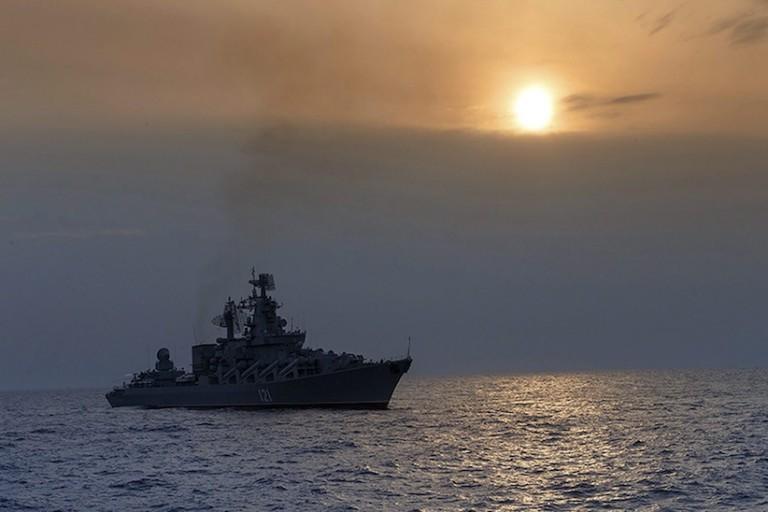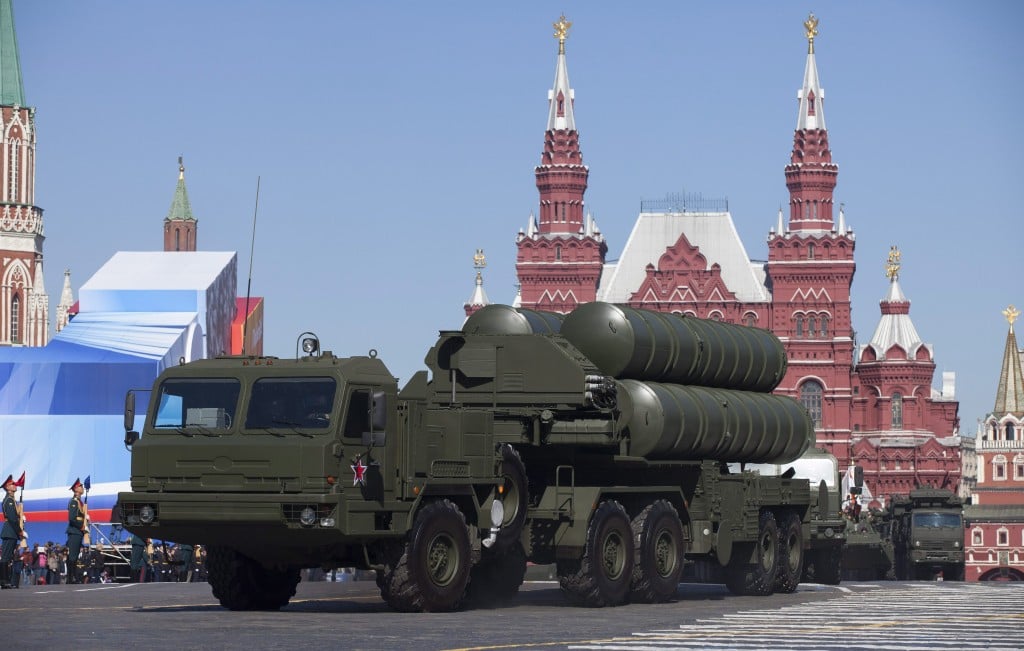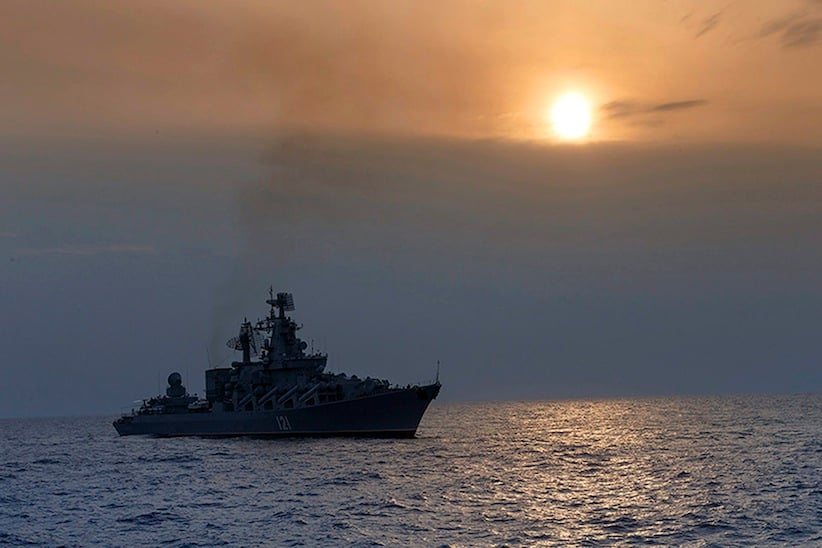How Russia used the war in Syria to reassert its global might
Russia’s game-changing intervention in Syria has been a showcase for its stunningly advanced military. And all eyes are watching.

This photo taken on Thursday, Dec. 17, 2015 and provided by the Russian Defense Ministry Press Service, shows the Russian missile cruiser Moskva on patrol in the Mediterranean Sea near the Syrian coast. The Russian military has deployed the Moskva closer to the shore to help protect Russian warplanes with its air defense missiles following the downing of a Russian bomber by Turkey at the border with Syria. (Vadim Savitsky/Russian Defense Ministry Press Service via AP)
Share

Little doubt remains now that U.S. foreign policy in Syria is failing spectacularly. It would have been less obvious even a few weeks ago. Back then, before Russia began its brutal bombing campaign in support of Syrian regime forces, President Barack Obama could still make an argument for his measured approach. In some ways, it was working: the Kurds, backed by Washington, were making progress against the delusional world-domination fantasies of the so-called Islamic State. The Assad regime was shrinking and increasingly desperate. Refugees fleeing regime-held areas were telling horror stories of a regime army desperate for conscripts. “If you could hold a gun and walk,” one refugee told Maclean’s last summer, “you were expected to fight.”
Russia’s entrance into the Syrian theatre has changed everything. Last week, Secretary of State John Kerry caused a stir in Washington policy circles after intimating that the U.S. was formulating a more aggressive “Plan B” to counter the Russians’ punishing offensive, which has helped regime forces rise again from the ashes of their near defeat. The plan was short on details but, according to one “senior official” speaking to CBS News, discussions included “military-like” dimensions, whatever that means.
But rather than set out a clear position, Plan B instead has only reinforced the perception that the U.S. administration has no clue about how to deal with Russia’s decisive involvement in Syria. A ceasefire deal hammered out last week was, most observers agree, merely a stopgap; it does nothing to turn the tide, nor does it appear to open the way for a negotiated settlement to the hostilities.
What it has done is show just how thoroughly Moscow is dictating events, from getting its way on which groups would be included in the ceasefire to setting the parameters of any talks that would follow. Russia, clearly, is now more than just winning in Syria. It has re-emerged as a major player on the world stage.
“We all really thought the Russians can’t operate in this way so far from their borders,” says Dmitry Gorenburg, a senior researcher at Harvard University’s Davis Center for Russian and Eurasian Studies. “It surprised everyone.”
Related: There’s nothing hopeful about Russia’s intervention in Syria
Surprise is an understatement. The speed with which the Russian military has realigned the ground reality in Syria speaks to a much more astonishing development in Russia’s capabilities. Indeed, according to most observers, Russia’s intervention in Syria has been as much a showcase for its reformed military as it has been an attempt to prop up a key ally. Escalating tensions has proven a useful tool for Moscow to flex its rehabilitated military muscle after decades of neglect.
“It’s not so much that Russia now possesses the same kind of advanced technologies as the Americans,” says Gorenburg, who has been tracking Russia’s military reforms since 2007, “but it’s what they have done with what they have: better inter-services coordination, better air cover, better naval air defence. They’re catching up to the innovations the U.S. made in the 1990s.”
Russian capabilities have not gone unnoticed in Washington. “Russia is a major military,” President Barack Obama conceded on Feb. 17. “Obviously a bunch of rebels are not going to be able to compete with the hardware of the second-most powerful military in the world.”
That’s a far cry from Obama’s tone in March 2014, when he described Russia as merely “a regional power that is threatening some of its immediate neighbours.”
The shift betrays the anxiety Washington and its NATO allies in Europe have been feeling ever since the Russian intervention in Ukraine at the end of 2014. Its annexation of Crimea, Gorenburg says, was the first test of its improved special-forces capabilities, who were largely responsible for taking the peninsula “with barely a shot fired.”
Other reforms have focused on creating smaller, sleeker, and better-networked professional armed services that can respond quickly to global events. “The shift to brigades from bulkier divisions has created more mobile forces with higher levels of readiness,” Gorenburg adds. “Russia has also shown its long-range capabilities. Firing precision cruise missiles at Syria from the Caspian Sea, for example, is primarily a demonstration for NATO. Russia doesn’t need to leave the Black Sea now to threaten Europe.”

Turkey is watching closely. Russian territorial expansion on the northern Black Sea littoral, beginning with the Georgian war in 2008 and then Ukraine six years later, has worried Turkey’s military establishment. The Turks control most of the Black Sea’s southern coast and its NATO member status makes it a frontline nation in a re-emerging Cold War set up. Growing Russian influence in the Middle East, particularly Russia’s deepening ties to Syria’s Kurds, has set off alarm bells in Ankara.
“There’s a great deal of concern among Turkey’s military leadership these days over Russia gaining a foothold both to the north and the south of Turkey,” says one senior Turkish official, requesting anonymity. “Turkey feels squeezed, and abandoned by its NATO allies.”
A recent flare-up in Syria, after Turkish fighter jets downed a Russian bomber last November, which Turkey claimed had crossed into its airspace, has put NATO leaders in an awkward position. Turkey’s bluster, premised in part on the belief that it has NATO’s backing, threatened to undo delicate negotiations with Russia over the ceasefire deal.
That deal is holding, for now. But Turkey has cautioned that it will not be bound by it if it feels its national security is threatened, and Russia has blamed Turkish forces for violating the agreement—a charge Turkey denies. Despite the relative calm, however, no one is under the illusion that the powder keg Syria has become is anywhere near defused.
European leaders worry that in a scenario leading to a Russia–Turkey conflict, Turkey may invoke Article 5 of the NATO treaty which guarantees that an “armed attack against one or more of [the alliance members] in Europe or North America shall be considered an attack against them all.”

But the tone in Europe is strongly opposed to such an outcome. “NATO cannot allow itself to be pulled into a military escalation with Russia as a result of the recent tensions between Russia and Turkey,” Luxembourg Foreign Minister Jean Asselborn warned. “The guarantee is only valid when a member state is clearly attacked.”
Russia has been careful not to push things that far and, according to Gorenburg, they have no interest in doing so.
“The Russians are still not in a position to project power globally,” he says, “but they now have the capabilities to be a major player in the Middle East. U.S. influence in the region has not been challenged in this way since the end of the Cold War.”
Meanwhile, Turkey’s Middle East strategy since the Arab Spring uprisings began in 2011—supporting Islamist movements like the Muslim Brotherhood in Egypt and Sunni rebels in Syria—is quickly unravelling. Instead of the leadership role Turkish President Recep Tayyip Erdogan envisioned for himself in the region, he now faces the very real possibility of a Turkey surrounded by enemies.
Russia is now once again threatening to become NATO’s primary concern. There is still the possibility, however, that Russia’s aggressive moves in Syria will be its undoing. The Middle East, as successive U.S. administrations have learned, is no place from which to set down geopolitical roots and project global power. Obama, perhaps rightly, decided early on in his presidency to disentangle U.S. interests from the Gordian knot of Middle Eastern conflicts. Russia, despite its growing strength, may very well someday learn that bitter lesson for itself.